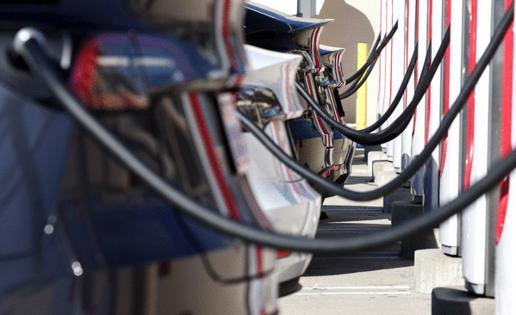Automakers get more time to ramp up EVs under final EPA emissions rules
Published in Automotive News
The U.S. Environmental Protection Agency said Wednesday its final automobile tailpipe emissions standards allow additional time for the automotive sector to scale up supply chains for electric vehicles and other alternative fuel powertrains in the latter half of the decade than it would have under a previous proposal.
The change partially shows the Biden administration bowing to requests by the automotive industry and the United Auto Workers, both of which represent a key voting demographic and called for moderation in regulations in light of slowing growth in EV sales. The rules, though, remain the "strongest-ever pollution standards for cars," according to an EPA news release.
Consumers remain hesitant to buy into all-electric vehicles because of high prices, limited charging infrastructure, charging speeds slower than filling a tank of gas and grid reliability concerns. Those circumstances have fueled criticism on the campaign trail of President Joe Biden from expected Republican nominee Donald Trump who has indicated he would seek to overturn the Biden rules if elected.
Trump has characterized the regulations as an EV "mandate" that will force Americans to buy vehicles they don't want and jeopardize jobs, while Biden has made subsidies in the clean-energy sector and slashed carbon dioxide emissions from gasoline-powered vehicles cornerstones in his environmental policy fighting climate change.
The final rules don't require customers to buy an EV, but are a performance standard that leaves it up to automakers to determine their sales mix of powertrains to comply with the greenhouse gas emissions limits for light-duty vehicle fleets of model years 2027 to 2032 and beyond.
The biggest differences from the preferred proposal last April by the EPA are in the first three years. For model year 2029, the total light-duty fleet standard is 136 grams of carbon dioxide per mile compared to 111 grams per mile under the original proposal.
For model year 2032, the final fleetwide light-duty rule places the limit at 85 grams of carbon dioxide per mile. That's compared to 82 under the original proposal, which to achieve at the lowest cost, the EPA at the time had forecasted would mean a 67% EV U.S. sales rate.
Under the final rules, the EPA says it expects the mix of EVs with plug-in hybrids, hybrid electric vehicles and cleaner international combustion engine vehicles to increase. It projects that from model years 2030 to 2032 at reasonable costs, manufacturers may choose to produce all-electric vehicles for about 30% to 56% of new light-duty vehicle sales with some of those other options, as well.
That's more in-line with industry projections, but a potential pullback from Biden's aspirations for half of new-car sales to be zero-emission by 2030.
The president in a statement said that's not the case: "We’ll meet my goal for 2030 and race forward in the years ahead."
U.S. EV sales hit a record 1.19 million last year, up 47% as market share rose to 7.6% from 5.8%. That growth, however, slowed toward the end of the year. Market research firm Guidehouse Inc. is forecasting EVs will represent 42% of the U.S. new-sales market in 2030.
Since noncompliance could result in fines for automakers, the longer runway of less stringent regulations compared to last year's EPA proposal gives the industry additional time before a greater share of the mass market makes the leap to EVs to address their affordability and technology challenges and for the national charging network to be built out.
The new rule is most similar to what the EPA in its original proposal had described as "alternative 3" that had achieved the same stringency as the agency's preferred proposed standards in model year 2032 but was accomplished at a more consistent rate of increase across the six years.
The more moderate path also may help to safeguard the rules from legal challenges. The EPA and other federal agencies in recent years have faced increased regulatory limits from the Supreme Court that's dominated by a 6-3 conservative majority. In 2022, a landmark ruling reined in the EPA's power to regulate carbon dioxide emissions from power plants.
The EPA estimates the light-duty standards along with final medium-duty standards will avoid 7.2 billion tons of carbon emissions by 2055, down from nearly 10 billion tons under the original proposal last year, and save 14 billion gallons of oil. It expects they'll provide nearly $100 billion in annual net benefits, including from public health benefits because of 95% less fine particulate emissions that can cause respiratory and other health issues and reduced fuel and maintenance costs.
EPA Administrator Michael Regan on Wednesday will join Biden’s National Climate Adviser AliZaidi at an event at noon in Washington, D.C., to announce the final standards with representatives from the auto sector in attendance.
“With transportation as the largest source of U.S. climate emissions, these strongest-everpollution standards for cars solidify America’s leadership in building a clean transportationfuture and creating good-paying American jobs, all while advancing President Biden’s historicclimate agenda,” Regan said in a statement. “The standards will slash over 7 billion tons of climate pollution, improve air quality in overburdened communities, and give drivers more clean vehicle choices while saving them money."
EV powertrains have fewer parts than their internal combustion engine counterparts, but the new rules come following legislation like the Bipartisan Infrastructure and Inflation Reduction acts that incentivize domestic and North American production of EVs and their purchases.
"On factory floors across the nation, our autoworkers are making cars and trucks that give American drivers a choice — a way to get from point A to point B without having to fuel up at a gas station," Zaidi said in a statement. "From plug-in hybrids to fuel cells to fully electric, drivers have more choices today. Since 2021, sales of these vehicles have quadrupled and prices continue to come down. This growth means jobs, and it means we are moving faster and faster to take on the climate crisis — all thanks to the President’s leadership.”
Although the changes represent delayed decreases in the emissions standards, environmental and health groups largely have communicated that the new rules represent steps toward protecting the planet and improving wellness.
"This common sense standard will not just save lives and deliver environmental justice," Matthew Davis, vice president of federal policy for the League of Conservation Voters, said on Tuesday ahead of the final rules during a virtual news conference, "it will make us less reliant on fossil fuels that wreak havoc on our family budget and economy."
Added Cara Cook, the Alliance of Nurses for Healthy Environments' director of programs: "We do see significant health benefits, and so I do think that is cause for celebration. Of course, we're never going to get exactly what we hoped for, and we will continue to advocate for the strongest possible standard."
Chris Harto, Consumer Reports' senior policy analyst for transportation and energy, noted that in the latter half of the time period the regulations cover, he forecasts there will be EVs with cost parity to or that are even less expensive than internal combustion engine vehicles.
"The only group that started to be upset about these rules is big oil," Harto said, "because consumers are going to be making a lot fewer trips to the pump."
_____
©2024 www.detroitnews.com. Visit at detroitnews.com. Distributed by Tribune Content Agency, LLC.







Comments